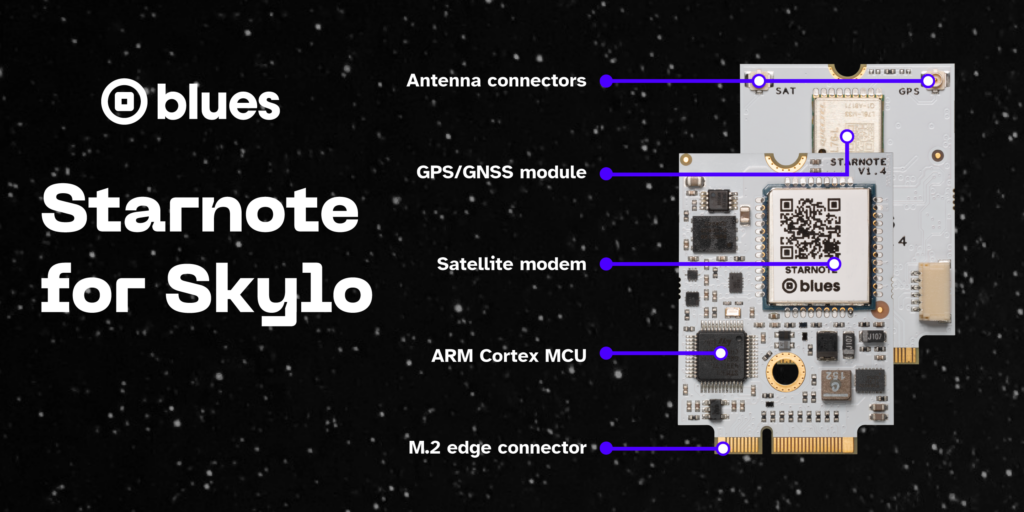Seamless communication and real-time data exchange have become essential for the industries that drive our global economy.
The transportation sector is facing a complex landscape of technological advancements, rising costs, and increasing demands for efficiency and safety. Reliable, uninterrupted connectivity is crucial in navigating these challenges. From managing data complexities to dealing with legacy infrastructure constraints, the journey towards a fully connected future has been anything but straightforward.
Blues’ Starnote for Skylo is overcoming the barriers that have hindered the adoption of satellite connectivity in transportation. By enabling improvements in efficiency, safety, and overall experience, the world is on the brink of experiencing the possibilities of global connectivity in transportation.
Driving Transportation’s Connected Future
In the transportation sector, the option to connect your devices via satellite marks a pivotal shift towards smarter, more efficient, and responsive systems. IoT in transportation is anticipated to increase from $186.12 billion in 2023 to $292.08 billion by 2029, with a CAGR of 7.8% during the forecast period.

Satellite IoT technology is transforming transportation by enhancing traffic management, public transit, electric vehicle systems, railway communications, as well as many other use cases. Here are some of the ways that access to real-time data and reliable connectivity is driving smarter, more connected transportation networks globally.
- Advancements in Traffic Management and Safety: Satellite IoT-powered intelligent transportation systems (ITS) can dynamically adjust traffic signals, provide real-time route guidance, and facilitate sustained communication between vehicles and infrastructure.
- Transforming Public Transit Systems: By installing IoT sensors on buses, trains, and other public transport vehicles and connecting them via satellite, transit authorities can monitor the location, speed, and condition of their fleet in real time. Satellite IoT also enables real-time passenger information systems, offering accurate arrival times, service alerts, and alternative route suggestions. This improves the convenience and accessibility of public transit.
- Facilitating the Adoption of Electric Vehicles: Satellite IoT is essential for the growing electric vehicle (EV) ecosystem. It allows for smart charging infrastructures, optimized battery management, and facilitates vehicle-to-grid (V2G) communication. Connecting EV charging stations via satellite enables real-time energy consumption monitoring, load balancing, and remote maintenance.
- Enhancing Railway Communications and Safety: Satellite IoT technology in railway systems allows for accurate tracking of trains, cargo, and passengers, optimizing logistics and improving security. It can also support personalized passenger services, including real-time travel updates, on-board entertainment, and paperless ticketing, to enhance the overall travel experience.
Turbulence in Transition: What’s Holding Us Back
However, establishing a robust and consistent connection can be difficult. Traditional land-based networks often struggle to cover remote and underserved areas, leading to communication gaps that can impede operations, compromise safety, and reduce efficiency.

Some of the connectivity issues that affect the transportation industry include:
- Value Chain Coordination: Aligning stakeholders within the transportation sector is no small feat. Each player has a distinct role and perspective, from manufacturers and service providers to regulatory bodies and end-users. While diversity is a strength, it also makes establishing universal standards and protocols incredibly complex.
- Use Case Fragmentation: Each use case, whether cargo tracking, smart manufacturing lines, or remote monitoring, has unique requirements and technological needs. This fragmentation makes it difficult to create a one-size-fits-all solution, necessitating a more tailored approach that can slow down standardization efforts and increase costs.
- Misaligned Incentives: Conflicting interests among stakeholders can also stall progress. For instance, connectivity providers invest heavily in infrastructure with the expectation of a return. Yet, the primary beneficiaries of enhanced connectivity may differ, leading to disputes over who bears the costs and reaps the rewards.
- Data Complexities: In an era where data is king, concerns around privacy, ownership, and interoperability loom large. Ensuring the security of transmitted data while navigating the labyrinth of global data protection regulations is a monumental task.
- Deployment Constraints: Finally, the legacy infrastructure of the transport sector, combined with regulatory uncertainties, acts as a brake on the adoption of new technologies. Upgrading existing systems to support advanced connectivity requires significant investment, and without clear regulatory guidelines, stakeholders are often hesitant to commit the necessary resources.
A robust, reliable solution is needed to fill these gaps and propel transportation forward. In areas where traditional networks cannot reach, satellite connectivity fills the void, ensuring operations can continue without interruption, regardless of location.
Buckle Up: Starnote in the Driver’s Seat

By embedding Starnote alongside the Blues Notecard you can experience true wireless harmonization enabling your devices to be connected via WiFi, Cellular, or Satellite depending on the local coverage for each channel. This solution allows transportation companies to unlock new levels of efficiency, safety, and global communication. Enabling optimized routing, predictive maintenance, and swift emergency response amongst many other benefits:
Optimized Operations and Efficiency
Starnote’s reliable backup connectivity provides real-time insights into asset performance, fuel consumption, and route efficiency. This data-driven approach enables fleet managers to make informed decisions, reduce operational costs, and improve overall efficiency. Moreover, predictive maintenance becomes possible, as Starnote allows for continuous monitoring of asset health, enabling proactive servicing and minimizing downtime.
Improved Safety and Emergency Response
With Starnote, vehicles can transmit critical data in real-time, regardless of their location. This enhanced connectivity allows for swift emergency response, as well as proactive monitoring of potential safety issues, such as engine anomalies or dangerous weather conditions. By enabling timely communication and data transmission, Starnote contributes to improved safety standards.
Real-time Data Exchange
Starnote enables continuous, real-time data exchange between assets, operators, and stakeholders, regardless of location. This perpetual flow of information, allows for the continual transmission of vital data, such as location, speed, fuel consumption, and engine performance, allowing operators to monitor and optimize their fleets in real-time. This enhanced visibility and communication foster a more agile and responsive ecosystem, where stakeholders can quickly adapt to changing conditions, mitigate risks, and seize opportunities as they arise.
Maintained Data Ownership and Enhanced Security
Starnote prioritizes data security and privacy by ensuring that all transmitted data is encrypted and protected. The Notecard’s robust security features, combined with Blues’ expertise in navigating global data protection regulations, help stakeholders comply with the complex landscape of data privacy laws. Furthermore, Starnote’s effortless integration with existing systems promotes data interoperability, allowing stakeholders to leverage the full potential of their data while maintaining control over its use and distribution.
Rapid Deployment and Adoption
By providing a flexible, easily integrated solution, Starnote helps bridge the gaps between manufacturers, service providers, regulatory bodies, and end-users. The Notecard’s developer-friendly API and low-code integration process enable stakeholders to adopt Starnote’s satellite connectivity without requiring significant changes to their existing systems or protocols.
Untangle Fragmentation
Starnote’s versatile design accommodates diverse use cases, from cargo tracking and passenger connectivity to remote monitoring. The Notecard’s modular architecture allows developers to tailor the solution to their specific needs, while still benefiting from the underlying satellite connectivity provided by Starnote.
The Catalyst For Connected Mobility
We can all move faster towards our destination when we know exactly what’s in front of us. By removing the ambiguity of spotty communication and the danger of driving blind (literally and figuratively), possibility takes on a whole new meaning.
Whether you’re a developer, a fleet manager, or an industry leader, the time to embrace the transformative potential of Satellite IoT is now. With Starnote as your gateway to an always-connected future, the open roads are calling.
